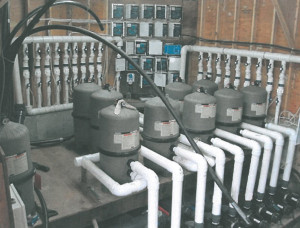Multiple residential units
Without a simple chlorine generating system available for commercial pools, those facilities that recognized the benefits of using these systems, and had the available space within their equipment rooms, along with sufficient capital to invest, opted to install multiple residential chlorine generating units.

Oftentimes, due to installation space and complexities, the systems were plumbed in a series configuration. This meant the salt cells were plumbed inline one directly after another. While this type of installation has been widely practiced, it does not represent the most efficient or cost-effective method of reaping the true benefits of salt chlorination. Studies have shown, when salt cells are installed in this manner, the system’s efficiency can potentially become compromised as the water moves through each successive salt cell.
More specifically, as electrolysis occurs within a cell, salt concentrations are depleted (as salt is converted to chlorine) and gas bubbles are generated, which affect the performance of the next successive cell. Chlorine production is predicated on an expected concentration of salt in the water; therefore, having cells configured in a series can deprive successive salt cells downstream of the proper salt levels required for optimum chlorine production.
More critical, however, is the presence of gas bubbles, which can disrupt the ability of the dissolved salt to come in direct contact with the chlorine generator’s active electrode surface. Only at the surface of the electrodes can the salt be converted to chlorine. When salt cells are installed in sequence, gas bubbles significantly interfere with the key mechanism of chlorine production by blocking the active surface area. For this reason alone, manifolds using a parallel flow path through multiple cells should only be employed when it is necessary to install multiple systems on a given pool.
Another issue that has been troubling commercial pool operators who are interested in installing these systems is properly sizing the equipment. Due to the initial cost of the equipment, available space in the pump room, and the expense of having to install multiple units, many systems that were being installed in the commercial pool market were undersized relative to the pool’s chlorine requirements. In these situations, operators found themselves in a position of not being able to sanitize their pools properly during peak hours of operation, forcing them to temporarily close their pools.
Future outlook
Salt chlorine generator manufacturers have recognized the need to provide equipment that not only satisfies the larger chlorine demands of commercial pools, but are also simple to install and compact in design. As a result, commercial systems that produce in excess of 2.26 kg (5 lbs) of chlorine per day with the use of a single-power supply and single-salt cell are now available. Further, the equipment footprint (both controller and salt cells) and their installation simplicity are comparable to residential units. With advancements in salt chlorine generating systems, coupled with a better understanding of their application in the commercial pool market, the use of this technology is more widely accepted. In fact, there is a significant demand.
What are the driving forces behind this trend?
The primary reason for the popularity of salt chlorination for commercial pools (and residential pools for that matter) are the three ‘Cs’—comfort, convenience, and cost. Salt chlorinated pools provide a level of bather comfort not realized in traditional chlorinated pools as the mild salinity of the water is closer to that of human skin cells and tears ducts (3,000 to 7,000 ppm), giving the water a softer, and more natural feel.
Additionally, because the equipment moderates the delivery of chlorine to the pool and prevents periods of low-chlorine concentrations, there are inherently less combined chlorines produced. Combined chlorines are the source of chloramines, which can create irritated eyes, itchy skin, and the chemical odours experienced in swimming areas. Studies have shown the excessive exposure to chloramines can result in breathing problems and even induce asthma among healthy individuals. For all the associated swimming comforts of a salt-chlorinated pool, many commercial pool owners/operators report their customers request their pool be converted to salt chlorination.
In fact, many owner/operators are generally happy to comply and make the conversion simply because of the convenience they are afforded by these systems. One clear cut example is the pool’s sanitization requirements become much more convenient as the need to haul and store heavy, corrosive, and sometimes flammable forms of chlorine are eliminated, or at least reduced significantly.
Further, owner/operators have also recognized the cost savings associated with making the switch. Pools maintained on standard chlorine sanitation programs are becoming more expensive to operate as chemical prices have increased dramatically in recent years. Using a sodium hypochlorite cost of $0.60/L ($2.25/gal), an average 189,000-L (50,000-gal) outdoor commercial pool (operated year-round) would consume more than $3,200 in chlorine per year. This is a significant cost of operation for a pool of this size.
On the other hand, salt chlorination has seen very little fluctuations in price in the last five years. New commercial salt chlorine generating systems are available that are less expensive than using multiple residential systems and yield the same or similar chlorine output. In estimating the annual operating costs associated with maintaining a typical commercial pool using liquid or tablet chlorine, and comparing it to the annual operating cost of a salt-chlorinated pool over a two-to-three year period, the costs are comparable. Despite the upfront expense associated with purchasing and installing the chlorine generating equipment, the money saved on an annual basis provides a quick return on investment (ROI).






